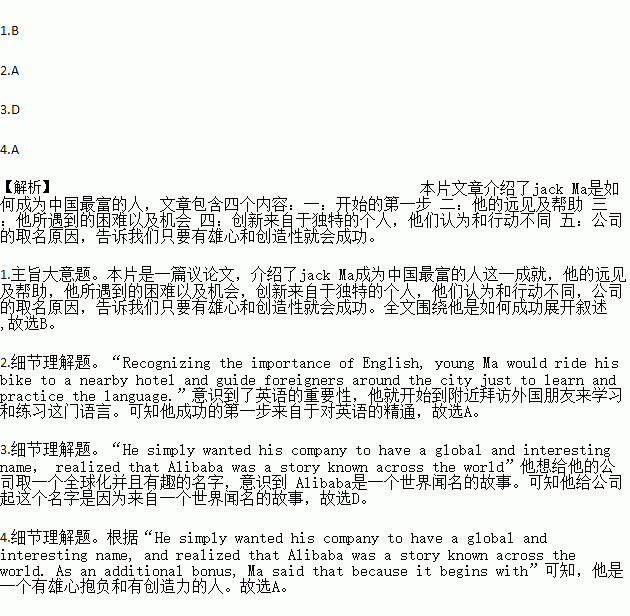题目内容
English teacher and Internet entrepreneur (企业家) Jack Ma founded Alibaba 18years ago in his tiny apartment in Hangzhou, China. Now, Ma has become the richest man in China. Every current entrepreneur and business leader should learn from how a Chinese English teacher became such a great success.
Start here, go anywhere. Recognizing the importance of English, young Ma would ride his bike to a nearby hotel and guide foreigners around the city just to learn and practice the language.
He has vision and he had help. Ma saw the Internet’s enormous potential to bridge businesses across China’s huge population early on. So he and his wife brought 17 friends together and pooled $60,000 to start the company. That formed the basis for the company’s dynamic partnership structure and unique culture.
Big problems lead to big opportunities. China’s lack of infrastructure (基础设施) has always been a problem for the enormous nation’s small businesses. Alibaba solved that and now accounts for 80% of the country’s e-commerce.
Innovation comes from unique individuals who think and act differently. Everyone talks about changing the world and making tones of money these days, but those who actually do it are exceptional individuals with breakthrough ideas, uncommon vision and a passion to do great work.
What’s is in a name? Jack Ma was sitting in a San Francisco coffee shop when he thought of how Alibaba overheard the secret of the 40 thieves in his story —“open sesame (芝麻)”—and unlocked untold riches. He simply wanted his company to have a global and interesting name, and realized that Alibaba was a story known across the world. As an additional bonus, Ma said that because it begins with A, it also appears at the top of lists.
1.The article is about ______.
A. Jack Ma’s life story B. the secrets to Jack Ma’s success
C. Jack Ma’s business team D. the development of Alibaba
2.According to the article, the first step in Jack Ma’s success came from ______.
A. mastering the English language B. the unique culture of his partnership
C. innovation from his team D. the foundation of his company
3.Jack Ma named his company after Alibaba because ______.
A. it begins with an A
B. his team worked out such a good idea.
C. inspiration came to him when he was listening to a story.
D. it came from a story that is well-known around the world.
4.Which of the following words best describe Jack Ma?
A. Ambitious and creative B. Humorous and innovative
C. Strict and intelligent D. Passionate and considerate


 ),并在其下面写出该加的词。
),并在其下面写出该加的词。